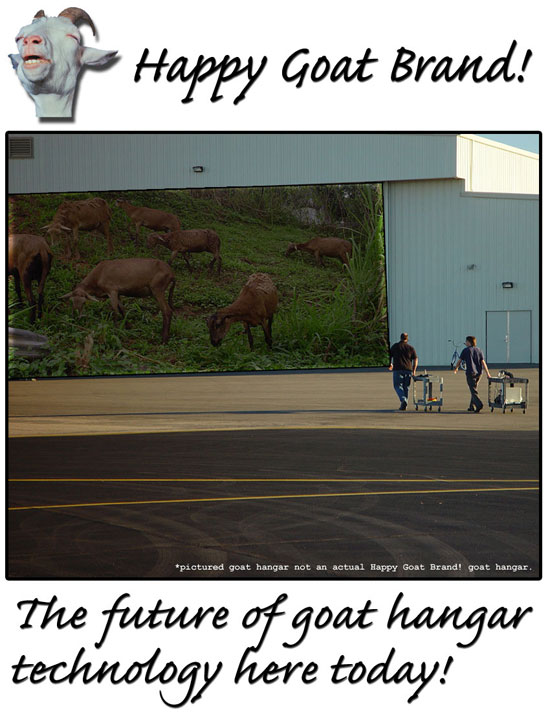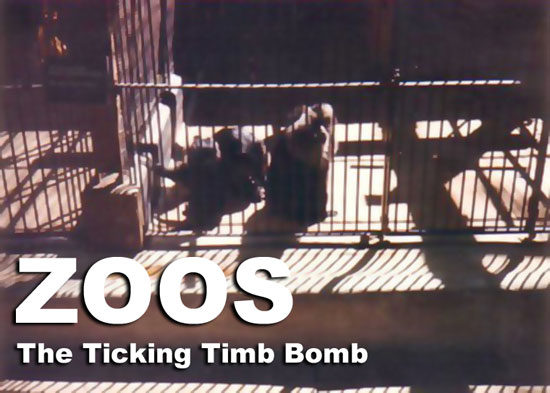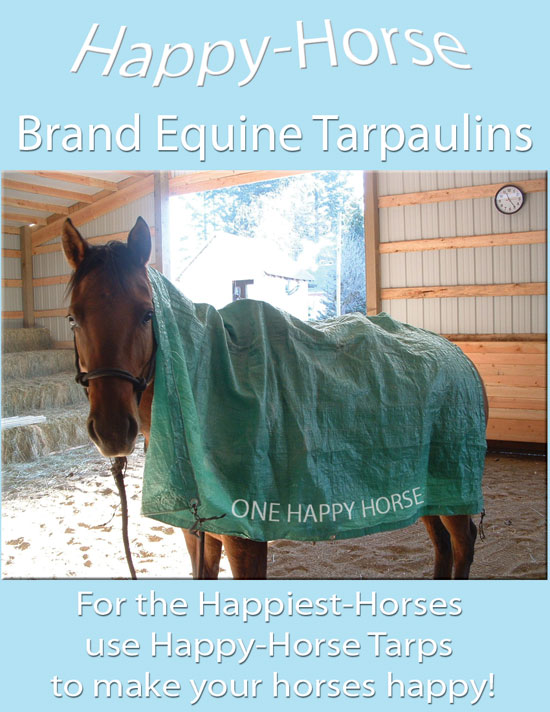
Monthly Archives: September 2007
Zoos

It is important for people of all ages to understand biology. After all, people are animals. For this reason, zoological gardens, otherwise known as zoos or wildlife parks can be found lurking within the depths of many of the world’s urban areas. There, near our schools, hospitals and churches, zoos bide their time, waiting silently to unleash a furry fury upon humanity. Zoos are a powder keg waiting to be ignited. Zoos are a ticking time bomb poised to destroy us all in a bloody orgy of claws, teeth, talons and fangs.
Perhaps you have been to a zoo and seen the variety of animals: cuddly koalas, cute little lemurs, majestic gorillas, and even regal lions. And perhaps you also spied the zookeepers, who, for some reason, wear safari-style khaki uniforms and hats. The zookeepers are the key to this impending catastrophe. Who cares for the menagerie? Who feeds the animals, cleans their enclosures and heals their wounds? That’s right. Zookeepers.
Without the zookeepers (The thin brown line) the zoos would be in chaos. Hungry tigers would greedily eat babies while nearby hyenas would fight over the carcasses of school field trip groups. In the dark corner, a content little monkey would lap up the pools of fresh crimson blood collecting around a dead grandmother whose face had been pecked apart and devoured by blue plumaged macaws.
By night the animals would escape their confines and stealthily invade our cities. Glowing eyes would be all the warning a sales executive would get before being ripped to sanguine shreds by a pack of vicious wolves. Venomous snakes would fly, via centrifugal force, from moving ceiling fans in suburban homes and sink their fangs into the faces of horrid, screaming housewives. After mastering the use of screwdrivers, chimpanzees would remove our doors, kill us in our sleep or cut the brakes on our city buses. Elephants would trample the elderly to death, crunching rib cages like potato chips and giraffes would bite flying kites out of the air and spit them back as children ran away crying. Society would collapse and hippopotamuses would eat our heads.
As you can now clearly see, we need two things if we’re to avoid this calamity:
1. Back up zookeepers, in case the regular zookeepers are sick or unable to work for some reason.
2. Secure locks on animal enclosures.
So, write your legislators and tell them that you do not want to be mauled by a zebra. Tell them America needs backup zookeepers and locks on the animal enclosures, lest we be destroyed. Thank you.
Your Life, Your Choice

Lions, Tigers and Bears
The Effects of the Megafauna on the Fall and Restoration of the Monarchy in Oz
by Jared Diamond
In the majority of his written works, scientist and author Jared Diamond attempts to show how the natural environment has influenced history. Previously, he has, with some skill, shown how distribution of biological resources led to the cultural predominance of Eurasian civilization and also how environmental factors precipitated the downfall of societies ranging from the Mayans to the Norse. Lions, Tigers and Bears tells a similar story; that of the collapse and eventual restoration of the Ozma government and how large animals came to play a crucial role in the unfolding political drama.
Diamond begins by examining the history of the realm of Oz and how its unique and tenuous monarchy came to power. Initially four separate sovereign nations; Munchkin, Gillikin, Quadling and Winkie became united by a monarchy which ruled from the city-state of Emerald City. It is through this history that Diamond makes the first and most crucial of his points; that geography made the eventual toppling of the monarchy a near certainty. Emerald City, situated on the central plain of Oz was unable to consolidate complete control over the rough and mountainous terrains in the outlying region. Throughout the Outlands, small societies were able to prosper in isolation and were often ignorant of the very existence of the centralized monarchy.

Furthermore, the cultures which grew up around the central plain were able to travel from one place to another easily, allowing for a cultural fusion of ideas, inventions and economies while the outlying mountainous regions and those beyond the Deadly Desert gave rise to isolated civilizations which could not share in the central plains culture. While the Ozma government could technically claim to rule the Land of Ez or the Dominions of the Nome King, the inhabitants of those lands, due to geography, would continually assert their independence causing a great deal of external stress to the central government. These outlying cultures developed societies entirely alien to the central plains societies; including differing religious systems and different domestication strategies. Thus, it was via environmental factors that Ozma was never able to consolidate complete control over the continent of Nonestica.
This would prove the monarchy’s undoing. Cultural fears of the desert and mountain regions made Ozma unwilling to expand. Without a coastline, and surrounded by alien cultures, the central plain became isolated, surrounded by hostile peoples. Continual attacks by the Nome King as well as by the Wicked Witches, a theocratic sect found in isolated mountainous regions of the West, weakened the power of the monarchy. The Wicked Witches were able to domesticate only one species; a flying monkey, found only in the mountains. The central plains societies were ill-adapted to fighting the soaring simians that would occasionally raid the central plains, further destabilizing the monarchy.
The flying monkeys (Brachyteles ecaudata) allow Diamond to introduce his thesis; the influence of the Megafauna on the collapse of Ozma’s government. The inhabitants of the central plains never domesticated any fauna, and were unable to cope with attacks by the flying monkeys. Thus, the Wicked Witches, with the help of the related sect of Wicked Wizards were able to expel King Pastoria of Oz and send his daughter Princess Ozma into exile. While Ozma was able to return to the throne for a short time, she was nevertheless unable to establish true governmental supremacy over the Land of Oz. After she was captured by the Nome King, the central government collapsed. With the central government non-existent, individual fiefdoms grew up and the influence of the trade unions, such as the Lollipop Guild, grew to fill the void of power in the lands.
Diamond then explores the issue of Megafauna, including central plains societies’ cultural aversion to large, predatory animals. Though the people of the plains feared lions, tigers and bears, it would be a lion, a rare form of forest-dwelling lion, that eventually helped secure a new dynasty in the Emerald City. Following the interregnum, the Scarecrow took control of the throne, though he was a weak monarch who ruled over a society near collapse. Trade had nearly broken down, infrastructure was ill-maintained and despite the numerous enemies on the borders, the army consisted of only one poorly built mechanical soldier. Though the Ozma monarchy was eventually restored, the problems inherent in Oz’s social, political and economic systems remain.
As an afterthought, Diamond presents a warning that societies such as the Land of Oz face important issues in their handling of the natural environment. Geographic pressures created a situation where the central plains people considered themselves invulnerable, while the outlying societies considered Oz ripe for the plucking. Had the denizens of Oz, Diamond asserts, taken a clear look at environmental and geographic factors, their society might not have been driven to near collapse.
While Lions, Tigers and Bears, is a good read, Diamond characteristically meanders through his ideas, stopping for several chapters to explore the evolutionary and agricultural history of meat trees. Indeed, the book presents a new and interesting take on the history of Oz, but generally only explores Megafauna in a few small sections, focusing instead on geology, weather and tectonics as an explanation of the political events in question while completely ignoring the fact that Megafauna in the lands in and around Oz would be apparently normal by Earthen standards. There have been several major scholarly works on political and economic life in the Land of Oz, but none have explored the bio-history of the region. Though Diamond’s writing has its faults, the issues he presents allow a new understanding of a troubled area’s past and possible futures.
Happy Horse

